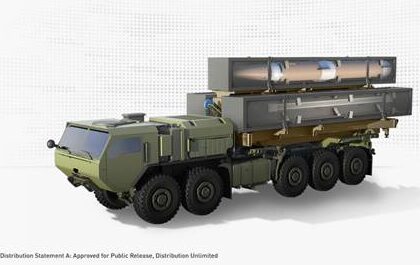Forget stupid China: USA’s plans: DARPA’s Hypersonic OpFires Aims For Army 1,000-Mile Missile – My Comments
(:E-:N-:R-AZ:C-30:V)
[Rest assured the US's hypersonic missiles will kick the shit out of anything stupid China can come up with. In modern weaponry, just because it looks like an aircraft or missile doesn't mean its good. It's the detailed racial technology inside that makes the difference. So don't be fooled by numbers. The USA is hell bent on keeping a super-strong military, so we are all safe. I am happy to see Europe growing stronger. The idiotic British probably should become another state or part of the USA. Those Liberal-loving British just need their daily fix of LIBERAL. They can't handle Europe. Jan]
WASHINGTON: The Army has not yet said which off-the-shelf missile it will modify to field a thousand-mile Mid-Range Capability in 2023 — but DARPA is already working on a replacement.
DARPA is developing a new intermediate-range weapon it calls Operational Fires, a reference to the theater level of war, between tactics and strategy. This year, DARPA is ground-testing three rival designs for a revolutionary “throttleable” rocket motor, with the winner going on to a full-up flight test in 2023. By that point, according to the current modernization plan, the Army will already have started buying an off-the-shelf MRC missile to meet immediate needs – but DARPA will have to convince the service that OpFires is the long-term solution it really wants.

Lockheed Martin concept for the DARPA OpFires (Operational Fires) surface-to-surface hypersonic missile.
Will the Army Want OpFires?
OpFires began 2017 as a joint Army-DARPA effort to develop a hypersonic weapon with a range between 500 and 5,500 kilometers (310 to 3,418 miles). That’s because the INF Treaty – later abrogated – banned cruise and ballistic missiles in that range band but (arguably) not hypersonics, which are neither. The Army provided $19 million for OpFires in 2020 and requested another $28 million for 2021 – but the service then decided to pull its funding.
Nevertheless, DARPA and prime contractor Lockheed Martin are still optimistic that what they’re building could be the Army’s long-term answer for its mid-range missile needs, and the service still gets regular briefings on OpFires’s progress. While the DARPA missile won’t be ready for fielding in 2023, it could “absolutely” lead to an operational Army weapon in the “later 2020s,” said DARPA’s program manager, Army Lt. Col. Amber Walker.
“We’re well-suited from a system development standpoint to catch them on the back end, [and] we are uniquely aligned to the Army’s medium-range gap,” Walker said in an interview. While the decision is up to the Army, she told me, “we certainly hope … it’ll be at least a compelling option for them to consider.”
Advancing Space-Based Defense ![B24617213.282002605;dc_trk_aid=475902820;dc_trk_cid=137613299;ord=[timestamp];dc_lat=;dc_rdid=;tag_for_child_directed_treatment=;tfua=;gdpr=$%7BGDPR%7D;gdpr_consent=$%7BGDPR_CONSENT_755%7D?](https://ad.doubleclick.net/ddm/trackimp/N7384.1813343.BREAKINGDEFENSE.CO/B24617213.282002605;dc_trk_aid=475902820;dc_trk_cid=137613299;ord=%5Bobject%202%5D;dc_lat=;dc_rdid=;tag_for_child_directed_treatment=;tfua=;gdpr=$%7BGDPR%7D;gdpr_consent=$%7BGDPR_CONSENT_755%7D?)
Learn how Raytheon Intelligence & Space is improving our ability to detect missile attacks.
From RAYTHEON INTELLIGENCE & SPACE
What would OpFires offer the Army it can’t get otherwise? It’s important that it’s both intermediate-range and hypersonic. In 2023, the Army plans to deploy both its first hypersonic missile, the Long-Range Hypersonic Weapon (LRHW), and its first intermediate-range missile since the Cold War Pershing III, the Mid-Range Capability (MRC). But it won’t have a weapon that’s both intermediate-range and hypersonic.
LRHW will be bigger, faster, and longer-ranged than MRC, flying “thousands of kilometers” as opposed to 1,800 km (1,118 miles). LRHW will also be much more expensive and relatively rare, reserved for the most important, distant, and difficult targets.
But just this year, the Army decided it needed MRC as well as a cheaper, more numerous weapon to strike larger numbers of less distant targets. That late start meant the Army couldn’t develop a new weapon by 2023, so it would need to modify a US or allied missile already in service – and none of those is hypersonic.
Having a smaller, cheaper hypersonic option alongside LRHW would be intriguing for Army commanders. “We view ourselves as complementary [to LRHW] and not duplicative,” Walker emphasized.
CSAF Brown Hedges On 386 Squadron Goal
“What I’m really trying to do is maximize my capability,” Air Force Chief of Staff Charles Brown says.
Significantly, Lockheed Martin has already selected the hypersonic glide body that will carry the missile warhead, coasting to the target (hence “glide body”) at Mach 5-plus once the rocket motors cut off. That glide body is the one Lockheed is already developing for the Air Force’s ARRW program (Air-launched Rapid Response Weapon). While the exact sizes of these weapons are classified, both DARPA and Lockheed Martin confirmed for me that the ARRW glide body is smaller than LRHW’s. That would allow the whole weapon to be smaller, which would make it cost less, too.
Why OpFires Would Be Revolutionary
OpFires isn’t just about building a smaller, cheaper hypersonic missile. If it were, DARPA wouldn’t bother, since the agency’s whole mission is high-risk, high-reward R&D. The “DARPA hard” part of the OpFires program is developing a revolutionary technology known as a “throttleable” rocket motor: In layman’s terms, a rocket that you can turn off at will, instead of having to wait until it burns through all its fuel.
You see, modern solid-fuel rocket motors have basically one setting: ALL AHEAD FULL. Once they’ve started burning and emitting thrust, you can’t turn them down or turn them off. (Liquid-fuel rockets don’t have this issue, but they pose other major problems in a military application). As a result, a solid-fuel rocket has trouble hitting targets that are significantly closer than its maximum range. You can make a long-range rocket hit a short-range target, but if you make it dive back towards the ground a lot earlier than it’s designed to do, that puts tremendous stress on the weapon, which could make it miss or even break apart in flight. That’s especially true for a rocket powerful enough to get the warhead moving at hypersonic speeds.
Simply put, Walker told me, “if you give it a lot of energy, it’s going to go far, and it’s actually really hard to make it go less far… without actually breaking it in the process.”
So instead of having a rocket motor you have to fight to rein in, you want a rocket motor you can just turn off when you’ve reached your target – a throttleable rocket. But that’s not easy either. For reasons of safety and reliability, solid rocket fuel is carefully formulated so it doesn’t either start or stop burning by accident, and historically no one tried to make it stop burning in mid-flight on purpose.
“Rocket motors are built to burn, and in this case, we’re trying to stop it when we want to,” Walker told me, “and, oh, by the way, also make it temperature-insensitive and safe for transport.” Army missiles in particular have to endure all sorts of conditions, from Arctic cold to desert heat to swampy humidity, and still fire reliably on command – and only when commanded to.
So in 2018, after a year of studies and consultation with the Army, DARPA contracted with three companies to develop throttleable rockets: Aerojet, Exquadrum, and Sierra Nevada Corporation (SNC). All three successfully demonstrated miniature versions of the motor and got further awards to build and ground-test a full-scale version. Exquadrum has completed that ground test, while Aerojet and SNC hope to do theirs before the end of the year. It’ll be up to Lockheed Martin, the prime contractor, to pick which of the three designs to use for the actual missile to be flight-tested in 2023.
A further wrinkle: The throttleable rocket motor will be the second stage of the OpFires rocket booster. The first stage launches the weapon and boosts it through the thickest part of the atmosphere, which requires different performance characteristics; it will be tested separately in November or December of next year.
Since the throttleable rocket motor is so tricky, DARPA and Lockheed Martin are trying to keep the rest of OpFires as simple as possible. Besides borrowing the ARRW program’s glide body, it’ll use the existing Army fire control system, AFATDS.It will require no new specialized support equipment; and its launcher will fit on the back of a common Army cargo truck, the 10-wheeler Palletized Load System (PLS). The weapon will fire from the back of the PLS in both the 2021 first-stage-only test and the 2023 full-up flight test.
What happens after that? TBD, Walker told me. DARPA’s job is to prove new technologies work, not to field them as integrated, combat-ready weapons systems: That’s the armed services’ job.
“A plan beyond 23? I can’t say that I have one today, but that’s clearly what we’re working to over the next year or two,” Walker told me. “In the ideal world, a service picks that up.”
The Navy might just be interested in OpFires as a lower-cost alternative to its own version of the long-range hypersonic weapon now that the House wants to place hypersonics on all US destroyers. But DARPA’s big bet is on the Army.
Source: https://breakingdefense.com/2020/10/darpas-hypersonic-opfires-aims-for-army-1000-mile-missile/
Video: Hitler: The Nightmares of an Emperor
When a man is as extremely powerful as Hitler was, he lives in a nightmare. I discuss an aspect of his character that all his enemies misrepresent in order to make him appear to be evil and demented.
Video: Do Liberals make you INSANE? The Assassination of the Liberal Allard Lowenstein: Part 1
We look at a rare event: When a male kills a Liberal, but not just any Liberal. He kills a Liberal he knew VERY WELL and whom he looked up to as an icon. Allard Lowenstein is a Liberal who was elected to congress once.
Best Independent Website that monitors Russian Tank losses in Ukraine War
Oryx is a brilliant independent Dutch website that monitors lots of military losses including the losses of Russian and Ukrainian tanks. They ONLY count vehicles that they can get photos of and can prove that these are the correct vehicles that were destroyed. This link will take you to see the verified Russian tank losses and you can click to see the photos.



